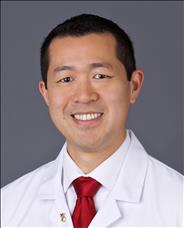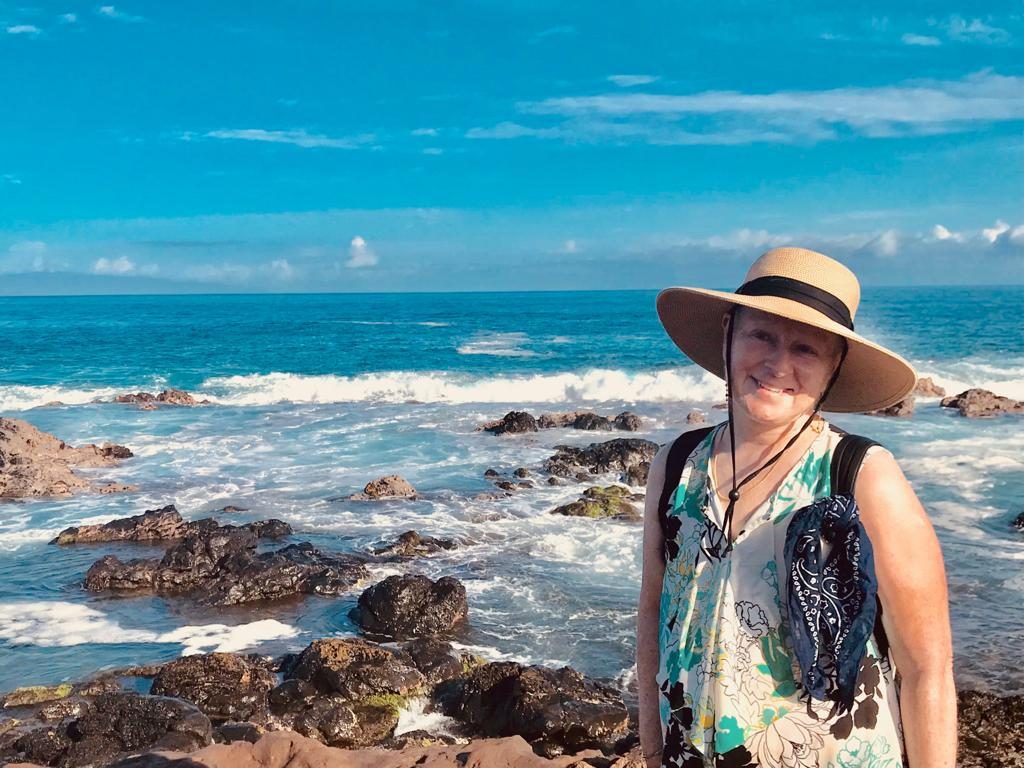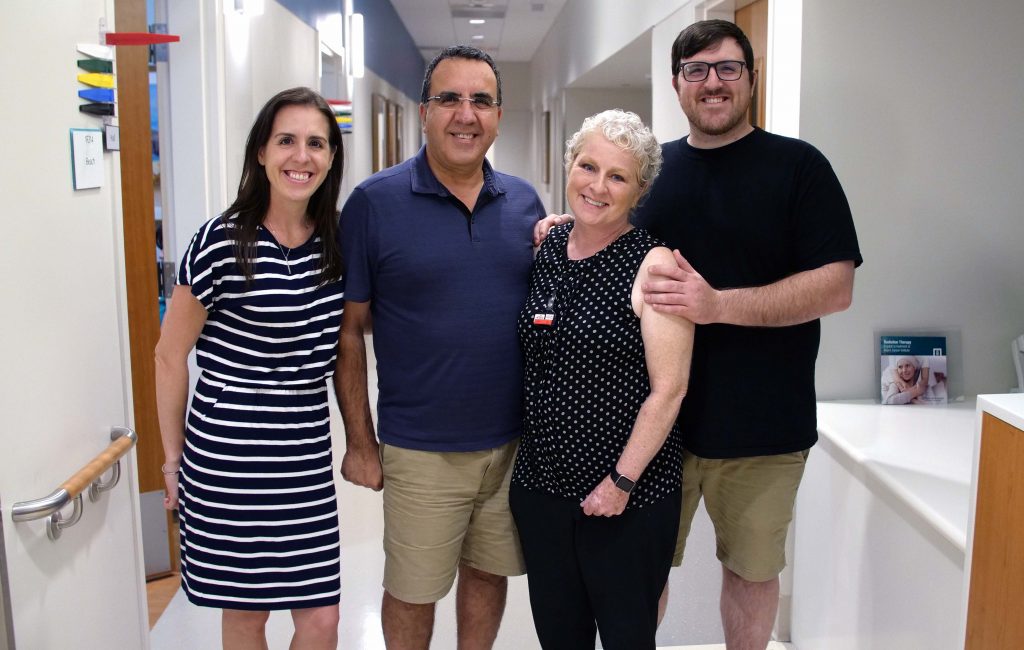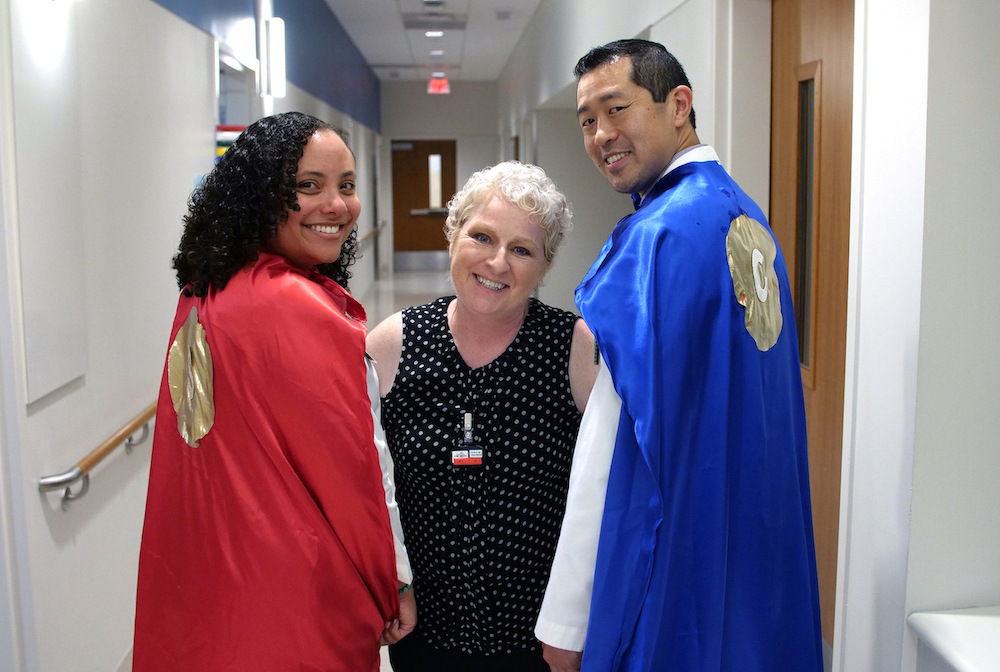April 8, 2020 by Adrienne Sylver
Targeted Therapy Gives New Hope to Pancreatic Cancer Patients

For people diagnosed with certain types of cancer, hope can be distressingly elusive. That’s especially true with pancreatic cancer, an insidious disease that offers few if any clues to its presence until it has already spread to other organs and the body’s lymphatic system.
Jayne Akhavan-Yazdi, 59, a neonatal nurse practitioner from Gainesville, Fla., was diagnosed with pancreatic cancer last autumn. She knew what lay ahead; her father died from the same disease when he was just 64, and she herself is a breast cancer survivor.
(Watch now: The Baptist Health News Team hears from patient Jayne Akhavan-Yazdi and her radiation oncologist, Michael Chuong, M.D., at Miami Cancer Institute. Video by George Carvalho.)
Mrs. Akhavan-Yazdi soon learned that surgery wasn’t an option – as is often the case with pancreatic tumors, because of their location – so her oncologist started her on chemotherapy. After a month of treatment, however, her pain had grown even worse and a subsequent scan showed her tumor was growing bigger, not smaller.
“I couldn’t even get off the sofa, I felt so exhausted and ill,” she says. “My care team in Gainesville told me surgery wasn’t an option and my fear was that additional chemotherapy might not be successful. I was devastated.”
Desperate yet still clinging to hope, Mrs. Akhavan-Yazdi enlisted the aid of her daughter, Suzie Black, a registered nurse with a cancer center in Ft. Myers. The mother-daughter duo researched and met with pancreatic cancer specialists and surgeons at top cancer centers around the country. None could help.
Then, a chance conversation Mrs. Black had with a work colleague in Ft. Myers led to her mother being referred to Michael Chuong, M.D., a radiation oncologist at Miami Cancer Institute who specializes in the treatment of gastrointestinal cancers. Dr. Chuong has gained worldwide renown in recent years for using magnetic resonance imaging (MRI)-guided radiation therapy on difficult-to-treat cancers.

“Miami Cancer Institute offers a truly comprehensive assortment of radiation therapy technologies, all under one roof,” Dr. Chuong says. “Whatever offers the best possible outcome for the patient, they can find it here, from traditional radiation therapy to pencil beam scanning proton therapy, Gamma Knife, Cyber Knife, and MRI-guided radiation therapy.”
Miami Cancer Institute is one of just a handful of cancer centers in the country – and the only one in South Florida – with the ViewRay™ MRIdian MR Linac technology, which safely delivers extremely high doses of radiation directly to the tumor by allowing physicians to continuously acquire a real-time MRI scan during the entire treatment. When the patient breathes, the machine automatically recognizes that the tumor has moved – even by just a few millimeters – and will pause until the tumor has returned to the appropriate location before resuming treatment. This technology is so advanced that the treatment can be modified on the fly based on even miniscule changes in the location of the stomach and bowel in relation to the tumor. This ensures that the dose to these organs remains at an appropriately low level, Dr. Chuong says.

In the 18 months it has been in place, Miami Cancer Institute has used the MRIdian Linac to treat 170-plus patients – one of the largest MRI-guided pancreas cancer volumes in the world. A fast-growing number of successful outcomes with MRI-guided radiation therapy has oncologists around the globe sitting up and taking notice.
According to Dr. Chuong, there is a lot of exciting research coming out, showing that very high ablative doses of radiation delivered via the MRIdian Linac can significantly prolong patient survival.
“We’ve had great outcomes with all sorts of different cancer types – pancreas, breast, lung, liver, prostate, esophagus, and others,” Dr. Chuong says. “Even patients with limited Stage 4 metastatic disease who typically would have been regarded as incurable could potentially have long-term disease control – and may even be cured – using ablative doses that can be safely given to certain tumors only with an MR Linac.”
Mrs. Akhavan-Yazdi’s initial consultation with Dr. Chuong on February 4th of this year gave her the hope she had so desperately been seeking in the four months since her diagnosis.
“Dr. Chuong’s office called in the morning and asked if I could see him that afternoon,” Mrs. Akhavan-Yazdi recalls. “We live five hours away in Gainesville but of course I said, ‘Yes!’ We jumped in the car and made it to Miami just in time for my appointment. After being at my lowest point just one month earlier, that one moment of hope made it the most exciting day ever.”
“When I first saw Jayne, her prognosis was quite poor,” says Dr. Chuong, who also serves as Proton Center Director, MRI-Guided Radiation Program Director, and Director of Clinical Research–Radiation Oncology at Miami Cancer Institute. “Her tumor was still growing – even with chemotherapy – and was considered unresectable, meaning it couldn’t be removed surgically.” He quickly determined she would be a good candidate for tumor ablation using the MRIdian Linac.
“Treating pancreatic cancers is a challenge because they’re resistant to lower doses of radiation, and also because the pancreas is so close to the stomach and bowel, both of which are especially sensitive to radiation,” Dr. Chuong says. “With the MRIdian Linac, however, we can deliver an extremely high, ablative dose of radiation to the tumor while at the same time delivering very little dose to nearby organs, resulting in most patients having little or no side effects whatsoever.”
With her daughter constantly by her side for support, Mrs. Akhavan-Yazdi began her daily outpatient treatment with Dr. Chuong on February 14th. The radiation Jayne received was more than twice the dose typically used with any other type of machine, according to Dr. Chuong. And her therapy took just five days, instead of the five to six weeks usually required for other, more conventional forms of radiation.
It can take time to see any noticeable improvement with radiation therapy, and Dr. Chuong didn’t expect to see much of a change immediately following Mrs. Akhavan-Yazdi’s treatment. After her first post-treatment scan, though, he was pleasantly surprised to see that her tumor had already started to shrink.
“I started feeling better straight away,” Mrs. Akhavan-Yazdi says with a sigh of relief. “I didn’t have any side effects, I could eat again, and I had my energy back. It was wonderful.”
Her daughter, too, could see instantaneous improvement. “You could see the difference in her color overnight, and the sparkle in her eyes was back,” Mrs. Black recalls. “As someone who works in oncology, it was a miracle for me to see Mum doing so well so quickly.”
Once she completed her treatment at Miami Cancer Institute, Mrs. Akhavan-Yazdi felt so good, she didn’t want to waste a moment not living her life to the fullest.

“Being as sick as I was, I hadn’t made any plans beyond simply trying to get better but now that I was feeling so well, my husband and I decided on the spur of the moment to take a much-needed vacation to Hawaii,” Mrs. Akhavan-Yazdi says. “Just one month after my treatment, we were aboard a ship cruising the Hawaiian Islands. It was so beautiful. I even climbed Diamond Head Monument, which I never could have imagined doing just a few weeks earlier.”
Since that trip, Mrs. Akhavan-Yazdi has traveled extensively around the United States and Europe, including the United Kingdom and Wales, where she grew up. She’s looking forward to more great adventures in the near future. “Christmas in New York would be wonderful,” she says with a twinkle in her eye.
She and her husband just celebrated their 40th wedding anniversary in September, and in December she plans to mark her 60th birthday in retro style with an ABBA-themed party for her family and friends. Her favorite ABBA song? “Why, ‘Dancing Queen,’ of course!”

In the meantime, Mrs. Akhavan-Yazdi comes back to Miami every few months for follow-ups with Dr. Chuong, who’s extremely pleased with the progress he’s seen.
“Jayne has had a great outcome so far – she’s a perfect example of how we can treat the tumor without compromising quality of life,” Dr. Chuong says. “She came to us desperate and seemingly out of options. Now, she’s had a dramatic turnaround. We’re seeing her tumor get smaller and, despite the really aggressive doses of radiation we delivered, she’s had no side effects of any significance.”

“I was in and out in just five days, and I didn’t have any side effects at all. This treatment truly saved my life,” says Mrs. Akhavan-Yazdi, who was so grateful for the care she received from Dr. Chuong and radiation oncology nurse practitioner Sonia Adamson, ARNP, that she gave them each superhero capes she made herself. “I just want to tell everyone in my situation, ‘Don’t give up hope! This treatment is amazing, and it works – I’m living proof!’”
top stories












There are no comments